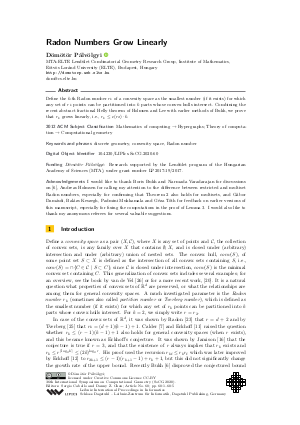Radon Numbers Grow Linearly
Author
Dömötör Pálvölgyi 
-
Part of:
Volume:
36th International Symposium on Computational Geometry (SoCG 2020)
Part of: Series: Leibniz International Proceedings in Informatics (LIPIcs)
Part of: Conference: Symposium on Computational Geometry (SoCG) - License:
 Creative Commons Attribution 3.0 Unported license
Creative Commons Attribution 3.0 Unported license
- Publication Date: 2020-06-08
File

PDF
LIPIcs.SoCG.2020.60.pdf
- Filesize: 394 kB
- 5 pages
Document Identifiers
Subject Classification
ACM Subject Classification
- Mathematics of computing → Hypergraphs
- Theory of computation → Computational geometry
Keywords
- discrete geometry
- convexity space
- Radon number
Metrics
- Access Statistics
-
Total Accesses (updated on a weekly basis)
0Document
0Metadata
Abstract
Define the k-th Radon number r_k of a convexity space as the smallest number (if it exists) for which any set of r_k points can be partitioned into k parts whose convex hulls intersect. Combining the recent abstract fractional Helly theorem of Holmsen and Lee with earlier methods of Bukh, we prove that r_k grows linearly, i.e., r_k ≤ c(r₂)⋅ k.
Cite As Get BibTex
Dömötör Pálvölgyi. Radon Numbers Grow Linearly. In 36th International Symposium on Computational Geometry (SoCG 2020). Leibniz International Proceedings in Informatics (LIPIcs), Volume 164, pp. 60:1-60:5, Schloss Dagstuhl – Leibniz-Zentrum für Informatik (2020)
https://doi.org/10.4230/LIPIcs.SoCG.2020.60
BibTex
@InProceedings{palvolgyi:LIPIcs.SoCG.2020.60,
author = {P\'{a}lv\"{o}lgyi, D\"{o}m\"{o}t\"{o}r},
title = {{Radon Numbers Grow Linearly}},
booktitle = {36th International Symposium on Computational Geometry (SoCG 2020)},
pages = {60:1--60:5},
series = {Leibniz International Proceedings in Informatics (LIPIcs)},
ISBN = {978-3-95977-143-6},
ISSN = {1868-8969},
year = {2020},
volume = {164},
editor = {Cabello, Sergio and Chen, Danny Z.},
publisher = {Schloss Dagstuhl -- Leibniz-Zentrum f{\"u}r Informatik},
address = {Dagstuhl, Germany},
URL = {https://drops.dagstuhl.de/entities/document/10.4230/LIPIcs.SoCG.2020.60},
URN = {urn:nbn:de:0030-drops-122183},
doi = {10.4230/LIPIcs.SoCG.2020.60},
annote = {Keywords: discrete geometry, convexity space, Radon number}
}
Author Details
Funding
- Pálvölgyi, Dömötör: Research supported by the Lendület program of the Hungarian Academy of Sciences (MTA), under grant number LP2017-19/2017.
Acknowledgements
I would like to thank Boris Bukh and Narmada Varadarajan for discussions on [B. Bukh, 2010], Andreas Holmsen for calling my attention to the difference between restricted and multiset Radon numbers, especially for confirming that Theorem 2 also holds for multisets, and Gábor Damásdi, Balázs Keszegh, Padmini Mukkamala and Géza Tóth for feedback on earlier versions of this manuscript, especially for fixing the computations in the proof of Lemma 3. I would also like to thank my anonymous referees for several valuable suggestions.
References
-
N. Alon, I. Bárány, Z. Füredi, and D. J. Kleitman. Point selections and weak ε-nets for convex hulls. Comb. Prob. Comput., 1:189-200, 1992.

-
N. Alon, G. Kalai, J. Matoušek, and R. Meshulam. Transversal numbers for hypergraphs arising in geometry. Adv. in Appl. Math., 29:79-101, 2002.

-
N. Alon and D. J. Kleitman. Piercing convex sets and the Hadwiger-Debrunner (p,q)-problem. Adv. Math., 96:103-112, 1992.

-
I. Bárány. A generalization of Carathéodory’s theorem. Disc. Math., 40:141-152, 1982.

-
I. Bárány and P. Soberón. Tverberg’s theorem is 50 years old: a survey. Bull. Amer. Math. Soc. (N.S.), 55(4):459-492, 2018.

- B. Bukh. Radon partitions in convexity spaces. arXiv, 2010. URL: http://arxiv.org/abs/1009.2384.
-
J. R. Calder. Some elementary properties of interval convexities. J. London Math. Soc., 2(3):422-428, 1971.

-
J. A. de Loera, R. N. La Haye, D. Rolnick, and P. Soberón. Quantitative combinatorial geometry for continuous parameters. Discrete Comput. Geom., 57(2):318-334, 2017.

-
J. A. de Loera, R. N. La Haye, D. Rolnick, and P. Soberón. Quantitative Tverberg theorems over lattices and other discrete sets. Discrete Comput. Geom., 58(2):435-448, 2017.

- J. A. de Loera, T. A. Hogan, F. Meunier, and N. H. Mustafa. Tverberg theorems over discrete sets of points. arXiv, 2018. URL: http://arxiv.org/abs/1803.01816.
-
J. Eckhoff. Radon’s theorem revisited. In Contributions to geometry (Proc. Geom. Sympos., Siegen, 1978), pages 164-185, Basel, 1979. Birkhäuser.

-
J. Eckhoff. The partition conjecture. Disc. Math., 221 (Selected papers in honor of Ludwig Danzer):61-78, 2000.

-
R. Fulek, B. Gärtner, A. Kupavskii, P. Valtr, and U. Wagner. The crossing Tverberg theorem. In Symposium on Computational Geometry (SoCG 2019), pages 38:1-38:13, 2019.

- A. F. Holmsen. Large cliques in hypergraphs with forbidden substructures. Combinatorica, 2019. accepted. URL: http://arxiv.org/abs/1903.00245.
- A. F. Holmsen and D.-G. Lee. Radon numbers and the fractional Helly theorem. Israel J. of Mathematics, 2019. accepted. URL: http://arxiv.org/abs/1903.01068.
-
R. E. Jamison-Waldner. Partition numbers for trees and ordered sets. Pacific J. Math., 96(1):115-140, 1981.

-
M. Katchalski and A. Liu. A problem of geometry in ℝⁿ. Proc. Amer. Math. Soc, 75:284-288, 1979.

-
S. Letzter. Radon numbers for trees. Disc. Math., 340:333-344, 2017.

-
F. W. Levi. On Helly’s theorem and the axioms of convexity. J. Indian Math. Soc., 15:65-76, 1951.

-
S. Moran and A. Yehudayoff. On weak ε-nets and the Radon number. In Symposium on Computational Geometry (SoCG 2019), pages 51:1-51:14, 2019.

- Z. Paták. Properties of closure operators in the plane. arXiv, 2019. URL: http://arxiv.org/abs/1908.01677.
- P. Patáková. Bounding Radon’s number via Betti numbers. arXiv, 2019. URL: http://arxiv.org/abs/1909.08489.
-
J. Radon. Mengen konvexer Körper, die einen gemeinsamen Punkt enthalte. Math. Ann., 83:113-115, 1921.

-
P. Soberón. Tverberg partitions as weak ε-nets. Combinatorica, 39:447-458, 2019.

-
H. Tverberg. A generalization of Radon’s theorem. J. London Math. Soc., 41:123-128, 1966.

-
M. L. J. van de Vel. Theory of convex structures, volume 50. North-Holland Mathematical Library, Amsterdam, 1993.

